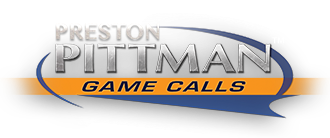TURKEY POT CALLS / HOW TO USE:
- Yelping – Make small circles 1/2” to 1” in length. Some people prefer making a “J” shape.
- Clucking – Pull the peg toward you about 1/8” to 1” with light pressure.
- Purring – Pull the peg toward you in a half-circle with light pressure.
- Cutting or Cackling – Pull the peg toward you 1/4” to 3/8”.
- To achieve proper turkey sound, apply more pressure to peg.
MAINTENENCE TIPS:
Choose one of Preston Pittman’s turkey pot calls made of slate, aluminum, glass and/or crystal. Remember to always keep the surface well sanded before each hunt. Never rub calling surface with your hand. Avoid oil or grease from coming in contact with the surface; but, if it does occur, simply sand properly. Harder surfaces, such as glass or crystal, need to almost be cut. Softer surfaces require the opposite.
- Glass or Crystal – Use a coarse grit sand paper such as a 60-grit.
- Slate or Aluminum – Use a fine grit sand paper, never coarser than a 220-grit. Finer is better. Scuff pads are best
MAINTENENCE TIPS:
- When sanding most hard surfaces, such as glass or crystal, crisscross sanding is preferred. Results from sanding should be similar to “###” marks on the caller. This insures that the caller can call from any direction.
- When sanding soft surfaces with a grain, such as slate, sand with the grain only. When calling, pull the striker across the grain. Aluminum can be crisscross sanded, but remember, on slate and aluminum, use fine sand paper or scuff pad.
- Hold the pot only by the rim. For maximum volume, do not touch the bottom of the pot.
- To tone the volume down, experiment with touching the bottom of the pot or hold the pot in the palm of your hand.
- The closer to the edge of the pot that you hold the turkey call, the higher the pitch will be. The closer you call to the middle of the pot, the deeper/coarser the sound will be.
- The greater the tilt of the peg, the coarser the sound will be.
- By using these tips, you can make any of Preston’s turkey pot calls sound like a whole flock of turkeys, or easily change from one sound to another.
DIAPHRAM TURKEY CALL / HOW TO USE:
- Place turkey caller in roof of mouth with reed pointing out. ALWAYS exhale air; NEVER inhale air through mouth. Exhale through mouth; inhale through nose.
- Hold in place by the back or middle of tongue – not the tip. If it tickles the tip of your tongue, move the caller further back. DO NOT PLACE TOO FAR BACK AS CHOKING MAY RESULT!!!
- The two ways to achieve the two notes of the basic hen yelp are; apply more (high note) or less (low note) tongue pressure or drop jaw slightly.
MAINTENENCE TIPS:
- Always keep turkey caller away from direct contact with sunlight or heat.
- For maximum rasp keep reeds separated by placing toothpicks or spacers between reeds.
- To preserve turkey caller, store in refrigerator between hunts. Between seasons place in box or bag and put in freezer.
- All multi-reed callers may be tuned. By letting some reeds stick together a different sound is achieved. The proper way is the long reed up, or tab touching the tongue.
Association words:
- Yelp: chick or chuck.
- Cluck: pick or pack.
- Cut or Cackle: pack, with a lot more air.
- Purr: fluttering the tongue or gargle, as if using mouthwash.
1 thoughts on “Call Tips”
Comments are closed.

Pingback: How to Call in Your First Turkey | NYBowhunter.com